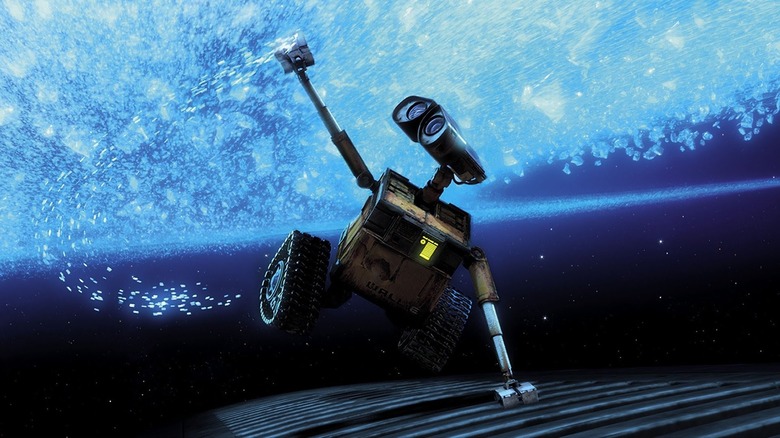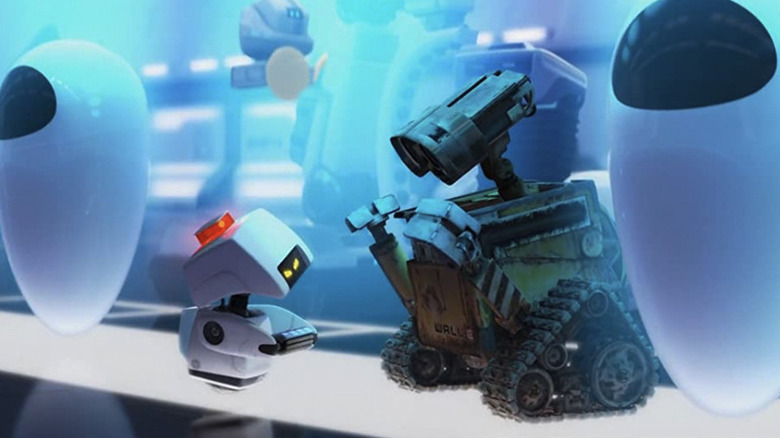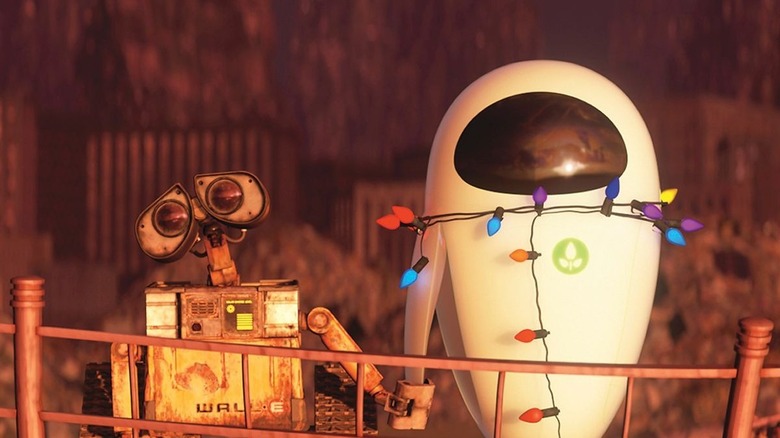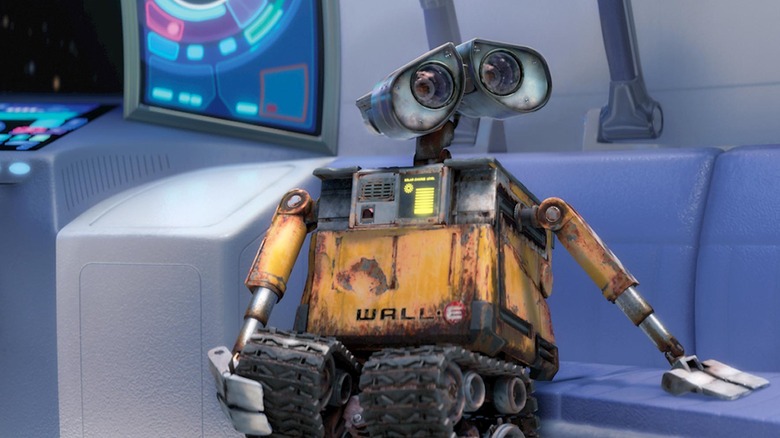Andrew Stanton Is Understandably Proud For WALL-E To Join The Criterion Collection [Exclusive Interview]
Over the course of nearly 25 years, the Criterion Collection has established itself as the premier home-media location for cinephiles to get pristine copies of French-language commentaries on World War II, the films of Wes Anderson, samurai epics, and everything in between. If there's one area where Criterion is lacking (relatively speaking), it's in the medium of animation. But this month, Criterion has welcomed a very big new addition to the collection with a new 4K release of the Oscar-winning Disney/Pixar film "WALL-E." The three-disc set (including one 4K disc with a new director-approved transfer of the sci-fi romance, and two Blu-ray discs) is predictably a feast for the eyes, and marks a very big milestone: This is the first Disney film to make its way to Criterion.
Recently, /Film was able to sit down with Andrew Stanton, the Academy Award-winning filmmaker who directed and co-wrote "WALL-E," to talk about how the wistful and companion-starved trash-collector robot wound up on the Criterion Collection, the film's still-resonant social commentary, and some of the cinematic touchstones that inspired Pixar's modern classic.
'It's going to get better at home'
This interview has been lightly edited for clarity and brevity.
When I saw the announcement that "WALL-E" was heading to the Criterion Collection, it was both delightful as a film fan but also surprising. How did this partnership come about?
A lot of people wonder, "Is this some big combination between the two companies?" I would love it if more films get this treatment that are in the Disney world, but it was just my personal request. Alan Bergman [Chairman, Disney Studios Content] was open to it, but he wanted to see if there was a there there. So we talked to Criterion and if they thought it wasn't worthy, then it would be a non-starter. But they thought it was.
That was in 2019, and then the pandemic hit. There was just a big pause on everything. I think it didn't hurt that the Library of Congress then added the film to its library [in 2021], and then we got serious again early last year. It was a personal endeavor.
With regards to Criterion's 4K transfer of the film, were there any specific touches or aspects of the visuals that stood out to you differently through this process?
Well, see, this is the weird thing: I only really watch these movies in the halls of Pixar. And then maybe I get to go to the premieres. And after you've seen it once or twice on the official premieres, then you're showing up at the ends of screenings, because you've seen the film about 100 times, and then you've seen it finished maybe about, to be fair, 20 times. I've always seen it at the highest [resolution], at the most level of detail. I sometimes have bemoaned, really in the '90s and the 2000s, that the rest of the world wasn't going to see it to this level. I feel like the rest of the world just finally gets to see what I've always seen.
Yeah, watching it on my 4K TV, it's remarkable to see. It feels like seeing it again for the first time.
It does for me, too, simply because I don't sit around watching it, and it's nice to suddenly have the means to see it. The only way I used to think I'd have [is] to drive all the way to Pixar and go into our nicest theater to see it that way. The cinephile in me would love to get in a time machine and go to my younger self and say, "It's going to get better at home. [laughing] Don't worry, it's not going to be this sh**** VHS for long."
'I was just trying to predict a believable future'
I was already planning to ask you a question about the film's social commentary, and then I watched the "Prophecies" supplement with you and [co-writer] Jim Reardon, where you discuss it yourselves. It's so stunning how much you unintentionally predicted in the film. In revisiting it now, how surprised were you?
I said it in the doc: I don't like being right on so many of those issues. I wasn't trying to predict the future. It's science fiction, not science fact. I was just trying to predict a believable future that you would buy so that we could accept that maybe humanity left and this character was alone. It was very selfishly just for character investment, but you want to go with things that don't distract you, like, "I don't buy that," because if the audience goes like that, they're not investing in the main character. You go with as much logic as you could possibly stretch it.
We're observant people. Animators are probably closer on the Venn diagram with comedians, because they're very observant of people and things going on around them and they're very sarcastic. It's probably not coincidence that "Idiocracy" came out, what, six months before "WALL-E?" Clearly, there were signs in the world with the increase and the nascent beginnings of social media, the beginnings of apps, but the introduction of the iPhone. I think apps hadn't even been mentioned yet. Just those seedlings were there. That's enough for very observant people to start extrapolating.
Regarding the inherent sarcasm among animators, I'm thinking of the dark joke you and Jim Reardon make about how the humans would all be dead six months after returning to Earth instead of what we see in the end credits.
[laughing] Yeah, you have to get that stuff out of your system in the room. You just don't put it on the screen. You also have to remember Jim came from "The Simpsons," he and I and Rich Moore and Ralph Eggleston, and a whole bunch of us were all in the same class [at CalArts]. That was our shibboleth — that was just how we talked to one another.
Then it became the language people were paying you to talk like, in both the irreverence of "Toy Story," which was a little bit cleaner and nicer, which was me, and then a little bit darker with Rich and Jim off at "The Simpsons." It's very much borne of just our type of generation.
That makes perfect sense. In one of the other new supplements, you talk about your growth as a cinephile and which films served as a touchstone for you in making "WALL-E." Two that stood out among the collage of posters that weren't talked about in detail are "The Party" and "Animal House."
Well, I showed little clips –- sometimes with dialogue –- that I thought were so powerful visually and in their actions. All your understanding of story and investment was by actions, visually, and by character choices. Sometimes there would be dialogue, and I would put it all in another language on the DVD, so that you would understand. It's easy for us to say now because "WALL-E" is done, but "WALL-E" didn't exist. I had to say, "This is the state of mind you'll be in when you watch the film I want to make." I'd either have something pure like "The Red Balloon" or "The Black Stallion," which had just music and action and atmosphere. But I knew there would be times when dialogue was said, and that your brain would be trying to interpret the emphasis of what their dialogue was.
On something like "The Party," it was just the Birdie Num-Num scene. It was the one where Peter Sellers finds the intercom and he doesn't know what it does and he starts talking into it and he's just saying one word again and again and again. It didn't matter what the word meant, it was just the sound and watching the sound wave and all the chaos in the house. That was the scene I showed from "The Party." From "Animal House," it was the racy scene with John Belushi on the ladder and being motivated by lust to get to the next window, just showing you how much characters' intentions and goals can be 100%, if not even more, clear to the audience.
You're even more invested, because, I used to say at the time, "It's like you watching a baby or a puppy." They can express themselves very well in a very endearing way, but they're limited and you're compelled to finish the sentence for them. That's a kind of drug that you don't get when there's a lot of dialogue and you're in an Aaron Sorkin film. You're kind of removed, and you're getting judge-y by what they're saying, and it's much harder to cut through and get invested. I wanted to flip it and go, "I'm in the Chaplin/Keaton world." You're 100% in.
'I'm not interested in dumbing things down'
You note both Charlie Chaplin and Buster Keaton. One of the supplements notes the romantic finale of Chaplin's "City Lights," and how it influences the end of "WALL-E," but you also called out Keaton's "Sherlock, Jr." for a similar connection as WALL-E tries to hold Eve's "hand" for the first time. Having seen "WALL-E" so many times, I hadn't thought of Keaton as a similar touchstone this way.
Well, we had seen all the Keaton films growing up in college. There was a marathon at the Nu Art in L.A. that showed a double feature every Monday and we got to see it with a full audience. It was really kind of catching up on Keaton. [On "WALL-E"], we watched everything at lunch for about three months. That's a lot of movies and a lot of shorts, and we began to quickly appreciate the smaller moments and the more complex ideas getting put across than the big gags, because that was kind of obvious to us. We wanted to learn the language. What else can you convey?
I was looking up among the nearly 1200 titles in the Criterion Collection –-
Jesus. Wow.
Well, and here's the thing, including "WALL-E," there are now six animated films in the collection.
Oh, really? Out of all that many?
Out of all that many. "Fantastic Mr. Fox" is one example. "Watership Down." You talked earlier about how this rose out of your desire, if possible, to have "WALL-E" be in the collection. There's so few animated films there and this gets to be one of them. What does that mean for you as a filmmaker and as a fan?
Well, as a filmmaker, it means the world. Probably up until I was 15, I was inspired and awakened by animation [from] Walt Disney to Bugs Bunny, and then it overlapped with blockbuster films. A lot of kids in the '70s started getting in from "Jaws" to "Star Wars" to "Blade Runner" and all the things. But at the same time, I was lucky to be ushering at an arthouse theater in our town, and I saw all these other films at the same time. They were just as formative and just as inspiring. I just didn't understand them as much, but they were having an effect.
I've always spent most of my memorable filmmaking and cinephile years straddling the popular and the obscure or the extreme or the minimalist. I always wanted to try and be able to appease both of those at the same time. There's a level of depth, sophistication, and complexity that I think, from the get-go, unconsciously to consciously, we've been trying to put into anything that I've been doing in animation. I'm not interested in dumbing things down. I'm interested in, how can I get you to want to read a more complicated book?
A lot of those [arthouse] films were films Criterion happens to have in its library, so I feel there's a kinship there. I just feel there's a certain beauty and complexity and embracing of the grayness of life that doesn't have to be shied away from all ages. It can be dealt with in a delicate enough way that prepares you better for how hard it is to go out and cross the street, and how hard it is to swim in the ocean when you can't guarantee that things are going to be good or bad.
I never signed up to be a babysitter or to hide the truth. I signed up for leaning into the truth and how do I make it as palatable as possible? So it's the opposite for me. I sometimes bristle at how a lot of the world sees and assumes what animation should do. I've always seen it as a means to do more than anybody, that it's completely underestimated and can do so much more. If [Criterion] thinks that about "WALL-E," then I'm very proud of it.
As a fan of animation, I completely agree. Before I wrap, I want to ask: Do you remember the first Criterion disc you purchased?
I think because of finances, I couldn't adopt them in the late '80s. I remember starting to have an income in '89-'90. My guess is it was "King Kong," even though that would have been out for a bit, and then the brand new "Taxi Driver." We're talking laser discs, 1990.
Similarly, what are your top five Criterion releases?
Oh, wow. Top of the list for me is the "Dekalog." It almost takes the whole top 10 if you have to count each one of them. "Matewan" is one of my favorite films of all time. And then "Local Hero." Probably "Defending Your Life." And the [three-disc] "Brazil" is right up there.
Those are all pretty great. As is the new WALL-E disc –- I'm so glad it's part of the Criterion Collection.
I'm so glad you're enjoying it.



